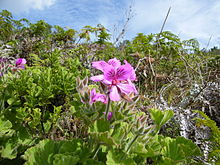Geraniums
| Pelargonium | |
|---|---|
 |
|
| Pelargonium cucullatum | |
| Scientific classification | |
| Kingdom: | Plantae |
| Clade: | Angiosperms |
| Clade: | Eudicots |
| Clade: | Rosids |
| Order: | Geraniales |
| Family: | Geraniaceae |
| Genus: |
Pelargonium L'Hér. |
| Type species | |
|
Pelargonium hirsutum (Burm. f.) Sol. ex Aiton |
|
| Subgenera | |
|
|
| Diversity | |
| At least 200 species | |
Pelargonium cucullatum
(L.) W. Aiton
Pelargonium /ˌpɛlɑːrˈɡoʊniəm/ is a genus of flowering plants which includes about 200 species of perennials, succulents, and shrubs, commonly known as geraniums (in the United States also storksbills). Confusingly, Geranium is the botanical name (and also common name) of a separate genus of related plants often called cranesbills. Both genera belong to the family Geraniaceae. Linnaeus originally included all the species in one genus, Geranium, and they were later separated into two genera by Charles L’Héritier in 1789.
Pelargonium species are evergreen perennials indigenous to temperate and tropical regions of the world, with many species in southern Africa. They are drought and heat tolerant, but can tolerate only minor frosts. Some species are extremely popular garden plants, grown as bedding plants in temperate regions.
The name Pelargonium is derived from the Greek , pelargós (stork), because the seed head looks like a stork's beak. Dillenius originally suggested the name 'stork', because Geranium was named after a crane — "a πελαργός, ciconia, sicuti vocamus Gerania, γερανός, grus" (as pelargos, stork, as we call the Gerania, geranos, crane). Despite the Latin, this should not be confused with the modern-day Ciconia genus, of birds in the stork family.
...
Wikipedia
